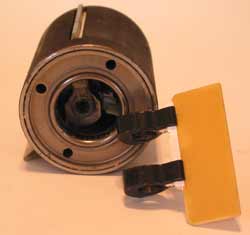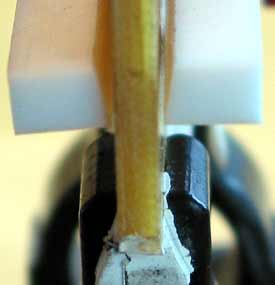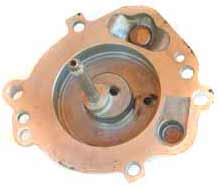| 
 |
| The vanes (this is a GZMS Super-Pro,
three-vane pump) are carbon-fiber and are attached to
“connecting rods” whose roller bearings ride
on the crank. |
Several aftermarket companies had been making drag racing
evacuation or vacuum pumps for some years featuring vane-type
operation, in which blade-like vanes slide in slots in the
central armature. As the pump spins, centrifugal force makes
the vanes come out to contact the interior of the pump, where
they drag across the surface to pump air, like a little blower.
Zucco learned that the constant drag of the vanes in centrifugal
pumps causes some parasitic losses, and that these losses
increased with rpm. Further, the pumps didn’t seem to
work well with oil vapor. The centrifugal pumps tended to
get sticky and needed cleaning after almost every meet. GZ
Motorsports now markets a complete line of brand-new vacuum
pumps for racing that encompass a different way to use vanes
in an air pump.
 |
| As modified by Zucco for racing
use, the vanes seal to the drum with strips of solid Teflon
that act like rings on a piston in the environment of
crankcase vapors. Equipped like this, pumps can handle
high-rpm use for several years before needing any service. |
GZMS’s Sportsman, Pro and Super-pro pumps are based
on brand-new Ford AIR pumps that have an armature rotating
in an eccentric motion, while the vanes slide in and out of
slots in the armature. When the crankcase vapors reach the
intake port of the pump, they are picked up in the large side
of the chamber and carried around to the smaller side, and
hence pressurized before they reach the outlet port. The big
difference between this and the other available racing vacuum
pumps is that in this case the vanes do NOT touch the inside
of the housing. They come very, very close but do not have
the material-to-material friction that, according to engineer
Zucco, is one of the causes of durability and efficiency problems
with conventional aftermarket vacuum pumps.
After considerable research in the world of pumps and vanes,
Zucco found that the OEM carbon parts were failing in high-rpm
use. Where the vanes move in and out of the slots in the armature,
they are in contact with seals on each side and a spring.
In the Toyota pumps, the plastic vanes were destroyed when
oil mist would ruin the carbon seals, which in turn would
wear enough that the springs would come out, immediately grenading
the pump. Everything he has learned through research and track/dyno
testing goes into his improved pumps that are a far cry from
the rebuilt import smog pumps he started with.
 |
| We think of crankshafts as having
offset throws, but the crank for these vacuum pumps is
a straight shaft. As the drum is rotated inside the pump
case, this stationery but offset shaft cause the vanes
to go in and out of the drum. |
GZ Motorsports blueprints brand-new Ford pumps, modifies
the inlet and outlet ports for more efficiency, makes provision
for attaching rubber or braided hoses, and replaces a number
of components inside the pump with parts made from pure Teflon
for superior sealing and high-rpm durability. The Ford pumps
have durable carbon-fiber vanes. A newer material promises
to give even longer pump life than the Teflon seals, and is
undergoing testing right now. All pumps are tested and dated
before delivery, and most are packaged with a complete mounting
and drive system. You can find all the small-to-large Chevy,
Ford and Mopar applications on the GZ Motorsports website,
and they also work with anyone who needs something for a special
application.
Experience with their many drag racing customers has give
GZMS a research base that helped develop their application
chart. You might think that if some vacuum is good, then more
is always better, but the pump does need to be matched to
the application. There is such a thing as too much vacuum
in the crankcase! The engine’s need for crankcase vacuum
is dependent on several factors, including the amount of blowby
(from wear and ring design, i.e. low-tension or not), displacement,
rpm range and whether there is a power-adder involved. When
you’ve got a blower or lots of happy-gas, there is going
to be more “windage” in the oil pan, and your
engine will need better evacuation to reach its full potential.
Conversely, if a pump is too big for the application, the
parasitic losses can outweigh much of the horsepower gains
from the vacuum pump, especially if your engine builder used
conventional rings, because vacuum pumps show their biggest
gains on engines with low-tension rings.
In Part Two of this story, we'll look at choosing the right
pump for various applications, and how an effective system
is plumbed and completed.
|

